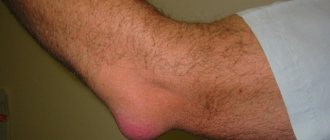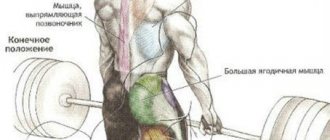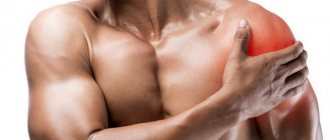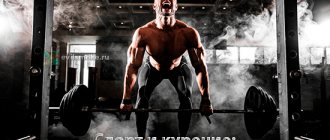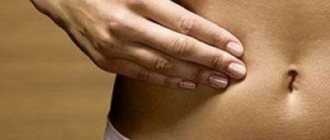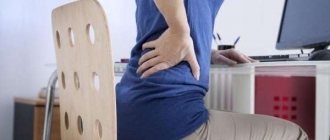Nausea during training is familiar, perhaps, to all novice athletes. As a rule, it appears when strength is already at its limit, and can torment not only beginners, but also advanced athletes.
I still get sick from time to time during CrossFit workouts when I'm pushing myself as hard as I can. This forces you to slow down or even stop so that you don’t have to use the bucket of magnesium for other purposes.
Below we will look at the two main causes of nausea and tell you how to cope with it.
Dehydration (lack of moisture in the body)
It occurs, among other things, due to increased body temperature and profuse sweating. On average, during high-intensity exercise, about 2-3% of body weight is lost, especially if the ambient temperature is quite high. A person begins to feel thirsty, as a rule, when dehydration is 5%, but this feeling can be dulled by the action of catecholamines (this type of substances, in particular, includes adrenaline and dopamine, released during intense training). Dehydration leads to delayed gastric emptying, which in turn can lead to nausea during exercise.
How to get rid of unpleasant feelings?
The easiest way to get rid of nausea or headaches directly in the gym would be the following options:
- Lie down with your head in a position higher than your heart. This will constrict the blood vessels, and the unpleasant sensation will pass very quickly.
- The second way to restore normalcy is to have a snack with something quickly digestible. An excellent option would be an apple or banana. These high-carbohydrate foods will replenish decreased glycogen stores, and the discomfort should go away.
Why do you feel nauseous after training? Another reason may be a simple lack of potassium and magnesium in the body. Take vitamins, preferably complex ones, for 2-3 months.
However, there is reason to worry if nausea and migraines become something familiar and regular after physical activity. In this case, the answer to the question of why you feel sick after training will be a recommendation to consult a doctor. There is a risk that you have a cardiovascular disease.
Training in a CrossFit gym has its own characteristics. First of all, it is high intensity, several times higher than this indicator for powerlifters or bodybuilders. Due to the extreme workload, CrossFitters often suffer from nausea after working out in the gym. What to do about it, how to avoid it, and how critical is it?
Increased penetration of toxins and allergens
Performing strenuous exercise promotes the penetration of toxins and allergens into the intestines, due to the weakening of the protective barrier of the stomach and intestines (the barrier is formed by a complex combination of membranes, nodes, mucus, and immunological factors). It can cause inflammation, systemic gastrointestinal complications, including nausea, vomiting, bloating, bloody diarrhea, and cramping. Among the foods that are dangerous for the penetration of toxins/allergens are cereals, seafood, peanuts, a variety of nuts, eggs, milk and vegetables.
Nausea during exercise
Physical stress on the body, in particular during sports training, can result in nausea, nausea and dizziness. In some cases, the nausea is so severe that it turns into vomiting. Similar situations arise in both beginners and professional athletes, especially those involved in strength sports, bodybuilding, etc. Nausea and dizziness are most often observed in cases where one workout includes exercises aimed at working large muscle groups. Nausea is a familiar condition for athletes who work long periods of time lifting heavy weights. Those who are just starting to seriously engage in strength sports are often frightened by sudden nausea and often stop training for this very reason.
Decreased pressure
During leg training, a significant amount of blood rushes to the lower part of the body, and blood flows away from the brain. In addition, blood vessels dilate, blood pressure decreases. Against this background, the consequences of pressure on the area of the carotid sinus (located in the area of the carotid artery) can be observed, which activates special cells (pressure can also occur due to compression of the artery by the mechanism of blood pressure regulation), which give a signal to the brain about compression of this area and triggers a neural response, causing the heart rate to contract and the blood arteries to dilate to relieve the resulting constriction. All this also has an effect on lowering blood pressure.
After completing the exercise, in order to equalize the balance, the body tries to redistribute the actively “gushing down” blood, narrows the blood vessels in the lower part and there is a sharp outflow of blood from the lower part to the upper part (and from the gastrointestinal tract as well), the heart cannot yet cope with blood flow, tachycardia may appear, but at the same time low blood pressure is still observed. Well, nausea, profuse sweating, dizziness, rapid heartbeat, epigastric discomfort, ringing in the ears are immediate signs of low blood pressure.
Prevention
What to do if you feel nauseous after training? No one is immune from nausea. First of all, you need to drink a sufficient amount of cool liquid and, if possible, eliminate the cause of the nausea itself. If nausea does not stop, the training process must be interrupted. But how can you reduce the risk of nausea?
There are some simple recommendations for a number of parameters:
- Training diary. It is needed so that you do not overload yourself in your next workout. Always write down not only your current results, but also make plans for your next workout. This will reduce the chance of overload.
- Nutrition. Eat food according to the precepts of Soviet trainers - that is, no later than 2 hours before the workout itself. At the same time, you need to eat in moderation, and before the workout itself it is better to load up on carbohydrates, and not proteins and certainly not fats.
- Breath. We have already written about the importance of breathing in each exercise in many articles. Proper breathing stabilizes blood pressure during the approach; in addition, it promotes complete aerobic glycolysis, which will not allow sugar to fall below a certain level.
- Liquid. Protects against overheating, in addition, during the training process you will experience severe dehydration and loss of sodium ions. Good mineral water without gas will help stop this process.
WHAT TO DO?
– Do not eat heavily before training. It is advisable to finish your meal at least an hour before exercise.
– You may need to eliminate various pre-workout supplements from your diet.
– Do not create a lake of water in the stomach, but at the same time do not allow the body to dehydrate. It is necessary to drink during training - at least half a liter is recommended.
– When the first signs of nausea occur (dizziness, increased sweating, blurred vision), you must interrupt the exercise and, ideally, lie down or squat down.
– After the symptoms have passed, continue the exercise, possibly reducing the intensity. Over time, the body will adapt and the load will be easier to bear.
– If nausea and so on are observed against the background of abnormalities: rhabdomyolysis, cholecystectomy, cardiac ischemia, pheochromocytoma, hypoglycemia, then you need to consult a doctor.
– For hypoglymic signs: dizziness, weakness, tremors in the limbs, cold sweat, (possibly, but not necessarily) nausea, loss of consciousness – you need to rest, sit down, eat some quickly digestible carbohydrates (a small chocolate bar, for example) or drink a cup of sweets tea. By the way, some may have a special reaction to taking protein/carbohydrates before training, which can lead to hypoglymic symptoms.
The text is based on the following research:
1. Effect of dehydration on gastrointestinal function at rest and during exercise in humans | Eur J Appl Physiol. 2000 Dec;83(6):578-84 | van Nieuwenhoven MA1, Vriens BE, Brummer RJ, Brouns F.
2. Abdominal symptoms during physical exercise and the role of gastrointestinal ischaemia: a study in 12 symptomatic athletes | Br J Sports Med. 2012 Oct;46(13):931-5. Epub 2011 Oct 20. | ter Steege RW1, Geelkerken RH, Huisman AB, Kolkman JJ.
3. Gastrointestinal ischaemia during physical exercise as a cause of gastrointestinal symptoms | Ned Tijdschr Geneeskd. 2008 Aug 16;152(33):1805-8. | ter Steege RW, Kolkman JJ, Huisman AB, Geelkerken RH.
4. The gastrointestinal system–an essential target organ of the athlete's health and physical performance | Exerc Immunol Rev. 1999;5:78-95. | Berg A, Müller HM, Rathmann S, Deibert P.
5. Excitatory effect of ATP on rat area postrema neurons | Purinergic Signal. Sep 2006; 2(3): 545–557. Published online May 30, 2006. doi: 10.1007/s11302-006-9004-4 | Masaru Sorimachia,corresponding author Minoru Wakamoria and Norio Akaikeb
6. Sinus node electrogram in patients with the hypersensitive carotid sinus syndrome | J Am Coll Cardiol. 1985 Jun;5(6):1484-90.| Gang ES, Oseran DS, Mandel WJ, Peter T.;
7. Exercise related syncope, when it's not the heart | Clin Auton Res. 2004 Oct;14 Suppl 1:25-36.| Krediet CT, Wilde AA, Wieling W, Halliwill JR
8. Postexercise hypotension. Key features, mechanisms, and clinical significance | Hypertension. 1993 Nov;22(5):653-64. | Kenney MJ, Seals DR.
9. Cardiodynamic responses during seated and supine recovery from supramaximal exercise | Can J Appl Physiol. 1995 Mar;20(1):52-64. | Kilgour RD, Mansi JA, Williams PA
10. Exercise-induced vomiting | Paweł Samborski, corresponding author Anna Chmielarz-Czarnocińska, and Marian Grzymisławski, Prz Gastroenterol. 2013; 8(6): 396–400. | Published online Dec 30, 2013. doi: 10.5114/pg.2013.39924 | PMCID: PMC4027831
11. Food-dependent, exercise-induced gastrointestinal distress | J Int Soc Sports Nutr. 2011; 8:12. | Published online Sep 28, 2011. doi: 10.1186/1550-2783-8-12 | PMCID: PMC3190328 | Erick Prado de Oliveira corresponding author and Roberto Carlos Burini
12. Lactate metabolism: a new paradigm for the third millennium | J Physiol. 2004 Jul;558(Pt 1):5-30. Epub 2004 May 6 | Gladden LB
13. Climatic heat stress and the exercising child and adolescent. American Academy of Pediatrics. Committee on Sports Medicine and Fitness. Pediatrics. 2000;106:158–159
14. Bouchama A, Knochel JP. Heat stroke. N Engl J Med. 2002;346:1978–1988. doi: 10.1056/NEJMra011089
15. Food-dependent, exercise-induced gastrointestinal distress | J Int Soc Sports Nutr. 2011 Sep 28;8:12. doi: 10.1186/1550-2783-8-12 | de Oliveira EP1, Burini RC.
Source: znatok-ne.livejournal.com
Why do you feel sick after training: the main reasons
For the most part, this can be caused by two main reasons: health problems or poor diet. Let's talk about this in more detail.
Blood pressure jumps
With unstable blood pressure, athletes may experience the following painful symptoms after physical activity:
• increased sweating; • dizziness; • shortness of breath; • darkening of the eyes, blurred vision; • and, actually, nausea.
Hypotonic people need to monitor their blood pressure on the day of training, and if there are changes, postpone the training. And in general, such people, before training, should consult with a sports doctor so that he can prescribe the necessary medications, recommend what is best to eat, and help draw up a training plan.
It can form due to excessive fatigue, lack of sleep, colds, headaches, depressed emotional state and other reasons. In addition, women feel unwell during menstruation. It is when you feel unwell that nausea often occurs, especially after strenuous physical training. In such cases, it is better for amateur athletes not to train at all, and for professionals to do light training.
Reduced blood sugar levels
If an athlete is training to lose weight, they will usually diet at the same time, eating low-carbohydrate foods. A low-carbohydrate diet plus physical activity - and, as a result, blood sugar drops. Hence the nausea. A balanced diet that includes foods with complex carbohydrates in the menu will help here. Or, as an option, you need to eat some fruit half an hour before training. But you don’t need to drink juice: it will, of course, sharply increase blood sugar, but it will also drop it just as sharply.
This problem is also called anemia. With anemia, you feel sick all the time, and even more so after training. In this case, you need to be examined by a doctor, and if the diagnosis is confirmed, take the medications prescribed by him that contain iron. You can train at the same time. True, the loads before the end of treatment should not be too heavy.
Overeating before exercise
Everything is simple here. You should try not to overeat before starting classes. And, of course, properly balance your diet.
There is not enough sodium in the body
This microelement maintains water-salt balance in the body. If the balance is disturbed, a person may feel nauseated due to lack of fluid in the body. Moreover, after physical activity, when sodium is removed along with sweat. The solution here is simple: you should exclude a salt-free diet during intense physical activity, drink mineral water, and do not give up salty foods.
This trouble occurs as a result of overheating of the body. A stuffy gym and a thermal suit that an athlete might wear when trying to lose weight are the main causes of heatstroke. Nausea, vomiting, confusion, incoherent speech, and lack of coordination are its main symptoms. In this case, the athlete needs to be taken out into fresh air, laid down and medical help called.
Blood flows poorly to the gastric mucosa
This usually happens with those who like to “pull iron”, and moreover, with those who wear special corsets or belts when working with equipment. If they are too tight and heavy, the stomach is compressed by them, blood stops flowing normally into the gastrointestinal tract, the digestion process is disrupted, and the contents of the stomach “ask to come out.” Hence the nausea. Therefore, it is better to avoid the mentioned belts and corsets, or wear them as a last resort, remembering to periodically unfasten them to ensure normal blood flow to the gastrointestinal tract.
Anything can play the role of an allergen - from the smell of sweat from your workout neighbor to the aroma of cologne emanating from the trainer. As a result, nausea, dizziness, swelling and even loss of consciousness may occur. It is better for allergy sufferers to train outdoors or in a well-ventilated room.
In general, the usual state of an athlete after training. But also very dangerous. Nausea in this case is the mildest symptom. In the worst case scenario, seizures may occur. To prevent this from happening, you need to periodically drink water in small quantities during training. Well, and, in addition, properly adjust your own diet, including foods with a sufficient amount of salt.
What to do to avoid nausea after training
To do this, you need to comply with several fairly simple conditions:
Why you feel sick after a workout and what it is not recommended to do after it ends to avoid this trouble, find out by watching the video.
Remember: nausea after exercise is a common problem. To avoid it, you need to figure out why it occurs. And work to eliminate the identified causes: if necessary, then with the involvement of specialists.
This problem is also called anemia. With anemia, you feel sick all the time, and even more so after training. In this case, you need to be examined by a doctor, and if the diagnosis is confirmed, take the medications prescribed by him that contain iron. You can train at the same time. True, the loads before the end of treatment should not be too heavy.

